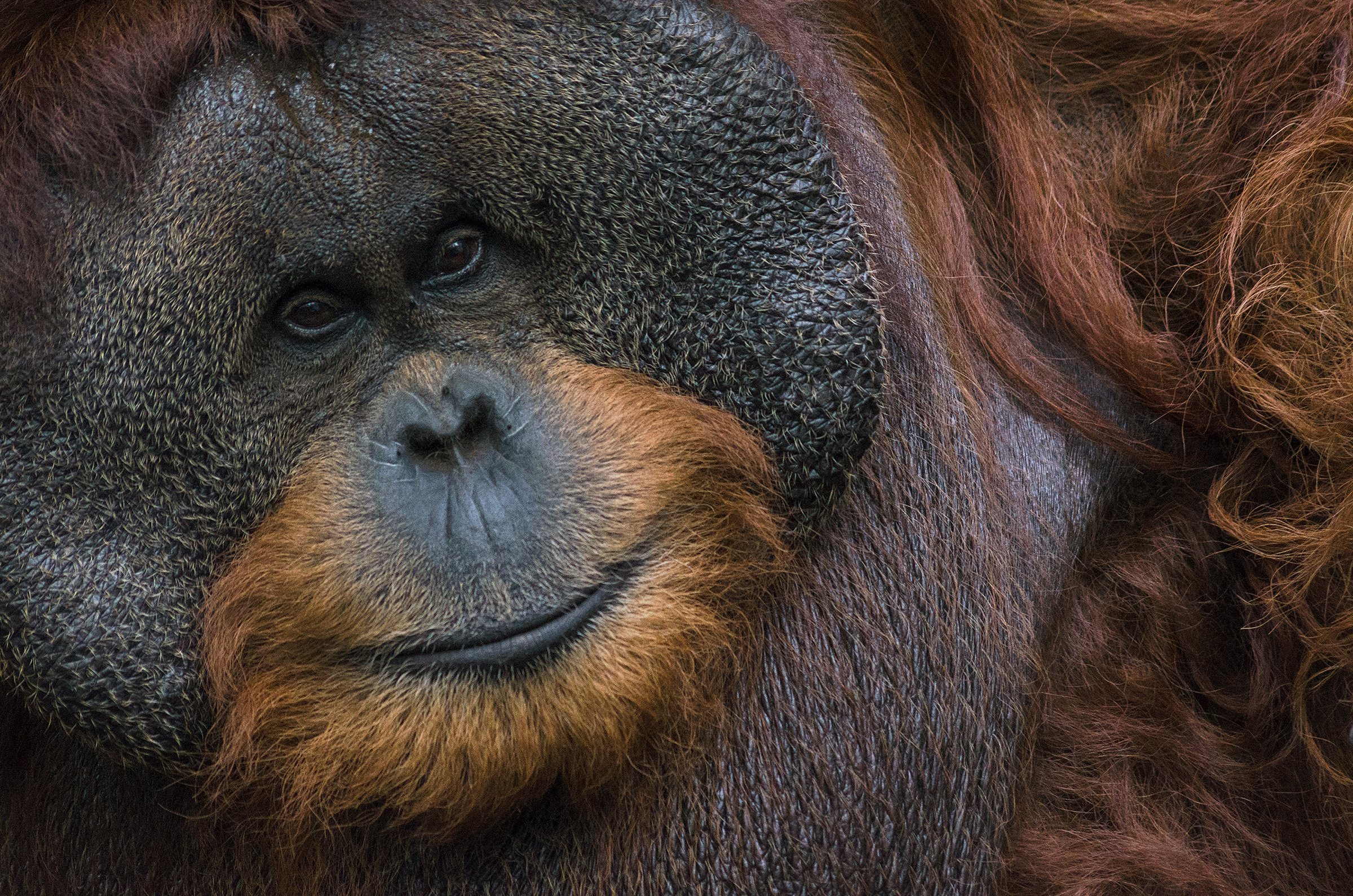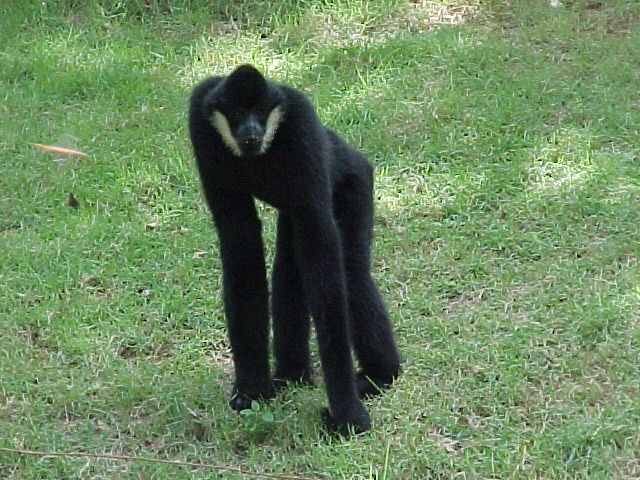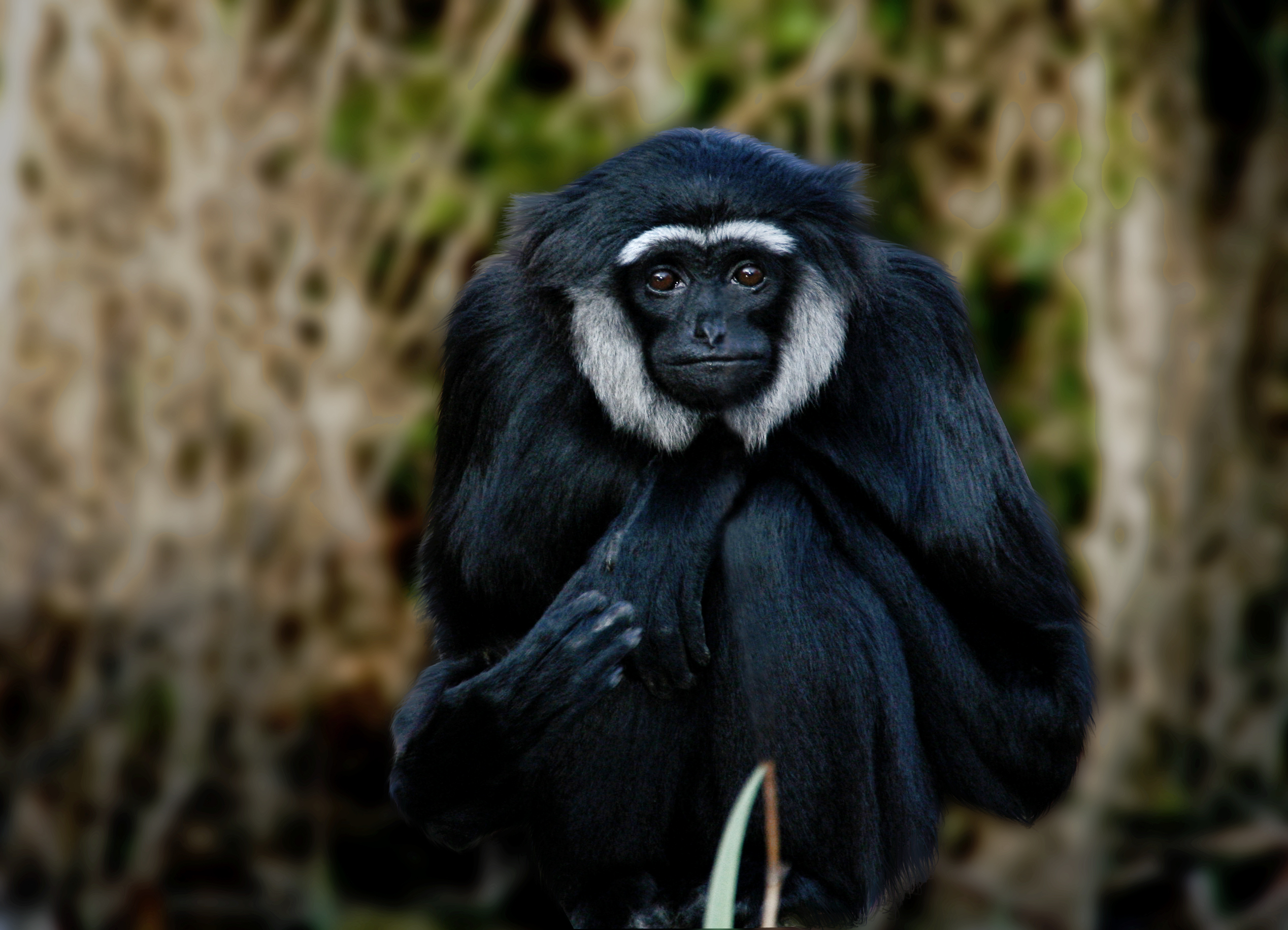|
Hominidae
The Hominidae (), whose members are known as the great apes or hominids (), are a taxonomic family of primates that includes eight extant species in four genera: '' Pongo'' (the Bornean, Sumatran and Tapanuli orangutan); ''Gorilla'' (the eastern and western gorilla); '' Pan'' (the chimpanzee and the bonobo); and ''Homo'', of which only modern humans remain. Several revisions in classifying the great apes have caused the use of the term ''"hominid"'' to vary over time. The original meaning of "hominid" referred only to humans (''Homo'') and their closest extinct relatives. However, by the 1990s humans, apes, and their ancestors were considered to be "hominids". The earlier restrictive meaning has now been largely assumed by the term ''"hominin"'', which comprises all members of the human clade after the split from the chimpanzees (''Pan''). The current meaning of "hominid" includes all the great apes including humans. Usage still varies, however, and some scientists and la ... [...More Info...] [...Related Items...] OR: [Wikipedia] [Google] [Baidu] |
Homininae
Homininae (), also called "African hominids" or "African apes", is a subfamily of Hominidae. It includes two tribes, with their extant as well as extinct species: 1) the tribe Hominini (with the genus ''Homo'' including modern humans and numerous extinct species; the subtribe Hominina, comprising at least two extinct genera; and the subtribe Panina, represented only by the genus ''Pan'', which includes chimpanzees and bonobos)―and 2) the tribe Gorillini (gorillas). Alternatively, the genus '' Pan'' is sometimes considered to belong to its own third tribe, Panini. Homininae comprises all hominids that arose after orangutans (subfamily Ponginae) split from the line of great apes. The Homininae cladogram has three main branches, which lead to gorillas (through the tribe Gorillini), and to humans and chimpanzees via the tribe Hominini and subtribes Hominina and Panina (see the evolutionary tree below). There are two living species of Panina (chimpanzees and bonobos) and two livin ... [...More Info...] [...Related Items...] OR: [Wikipedia] [Google] [Baidu] |
Hominini
The Hominini form a taxonomic tribe of the subfamily Homininae ("hominines"). Hominini includes the extant genera ''Homo'' (humans) and '' Pan'' (chimpanzees and bonobos) and in standard usage excludes the genus ''Gorilla'' (gorillas). The term was originally introduced by Camille Arambourg (1948). Arambourg combined the categories of ''Hominina'' and ''Simiina'' due to Gray (1825) into his new subtribe. Traditionally, chimpanzees, gorillas and orangutans were grouped together as pongids. Since Gray's classification, evidence has accumulated from genetic phylogeny confirming that humans, chimpanzees, and gorillas are more closely related to each other than to the orangutan. The former pongids were reassigned to the subfamily Hominidae ("great apes"), which already included humans, but the details of this reassignment remain contested; within Hominini, not every source excludes gorillas, and not every source includes chimpanzees. Humans are the only extant species in t ... [...More Info...] [...Related Items...] OR: [Wikipedia] [Google] [Baidu] |
Primate
Primates are a diverse order of mammals. They are divided into the strepsirrhines, which include the lemurs, galagos, and lorisids, and the haplorhines, which include the tarsiers and the simians ( monkeys and apes, the latter including humans). Primates arose 85–55 million years ago first from small terrestrial mammals, which adapted to living in the trees of tropical forests: many primate characteristics represent adaptations to life in this challenging environment, including large brains, visual acuity, color vision, a shoulder girdle allowing a large degree of movement in the shoulder joint, and dextrous hands. Primates range in size from Madame Berthe's mouse lemur, which weighs , to the eastern gorilla, weighing over . There are 376–524 species of living primates, depending on which classification is used. New primate species continue to be discovered: over 25 species were described in the 2000s, 36 in the 2010s, and three in the 2020s. Primates ha ... [...More Info...] [...Related Items...] OR: [Wikipedia] [Google] [Baidu] |
Orangutan
Orangutans are great apes native to the rainforests of Indonesia and Malaysia. They are now found only in parts of Borneo and Sumatra, but during the Pleistocene they ranged throughout Southeast Asia and South China. Classified in the genus ''Pongo'', orangutans were originally considered to be one species. From 1996, they were divided into two species: the Bornean orangutan (''P. pygmaeus'', with three subspecies) and the Sumatran orangutan (''P. abelii''). A third species, the Tapanuli orangutan (''P. tapanuliensis''), was identified definitively in 2017. The orangutans are the only surviving species of the subfamily Ponginae, which diverged genetically from the other hominids (gorillas, chimpanzees, and humans) between 19.3 and 15.7 million years ago. The most arboreal of the great apes, orangutans spend most of their time in trees. They have proportionally long arms and short legs, and have reddish-brown hair covering their bodies. Adult males weigh about , while f ... [...More Info...] [...Related Items...] OR: [Wikipedia] [Google] [Baidu] |
Bornean Orangutan
The Bornean orangutan (''Pongo pygmaeus'') is a species of orangutan endemic to the island of Borneo. Together with the Sumatran orangutan (''Pongo abelii'') and Tapanuli orangutan (''Pongo tapanuliensis''), it belongs to the only genus of great apes native to Asia. Like the other great apes, orangutans are highly intelligent, displaying tool use and distinct cultural patterns in the wild. Orangutans share approximately 97% of their DNA with humans. Also called mias by the local population, the Bornean orangutan is a critically endangered species, with deforestation, palm oil plantations, and hunting posing a serious threat to its continued existence. Taxonomy The Bornean orangutan and the Sumatran orangutan diverged about 400,000 years ago, with a continued low level of gene flow between them since then. The two orangutan species were considered merely subspecies until 1996; they were elevated to species following sequencing of their mitochondrial DNA. The Bornean orangutan h ... [...More Info...] [...Related Items...] OR: [Wikipedia] [Google] [Baidu] |
Eastern Gorilla
The eastern gorilla (''Gorilla beringei'') is a critically endangered species of the genus ''Gorilla'' and the largest living primate. At present, the species is subdivided into two subspecies. There are 3,800 eastern lowland gorillas or Grauer’s gorillas (''G. b. graueri'') and 1,000 mountain gorillas (''G. b. beringei''). Illegal hunting threatens the species. Taxonomy and phylogeny There are two recognised subspecies of eastern gorilla: the mountain gorilla (''Gorilla beringei beringei'') of the volcanic slopes of Rwanda, Uganda and eastern Democratic Republic of Congo; and the eastern lowland gorilla or Grauer's gorilla (''Gorilla beringei graueri'') in eastern Democratic Republic of Congo. The eastern lowland gorillas and mountain gorillas were previously thought to be two of the three subspecies of one single species, the gorilla (''Gorilla gorilla''). However, genetic research has shown that the two eastern subspecies are far more closely related than the western ... [...More Info...] [...Related Items...] OR: [Wikipedia] [Google] [Baidu] |
Western Gorilla
The western gorilla (''Gorilla gorilla'') is a great ape found in Africa, one of two species of the hominid genus ''Gorilla''. Large and robust with males weighing around , the hair is significantly lighter in color than the eastern gorilla, ''Gorilla beringei'', and geographically isolated from them in a region at the midwest of the African continent. Two subspecies are recognised, '' Gorilla gorilla diehli'' (Cross River gorilla) is limited to a smaller range in the north at the border of Cameroon and Nigeria, both are listed Critically Endangered. Taxonomy A formal description of the species was provided by Thomas Savage in 1847, allying the new species to an earlier description of the chimpanzee as ''Troglodytes gorilla'' in a group of eastern simians he referred to as " orangs". The author selected the specific epithet for the name given by Hanno to "wild men" he had noted on the east coast of Africa, presumed by Savage to be a species of orang. The population is recogni ... [...More Info...] [...Related Items...] OR: [Wikipedia] [Google] [Baidu] |
Gibbon
Gibbons () are apes in the family Hylobatidae (). The family historically contained one genus, but now is split into four extant genera and 20 species. Gibbons live in subtropical and tropical rainforest from eastern Bangladesh to Northeast India to southern China and Indonesia (including the islands of Sumatra, Borneo and Java). Also called the lesser apes, gibbons differ from great apes (bonobos, chimpanzees, gorillas, orangutans and humans) in being smaller, exhibiting low sexual dimorphism, and not making nests. Like all apes, gibbons are tailless. Unlike most of the great apes, gibbons frequently form long-term pair bonds. Their primary mode of locomotion, brachiation, involves swinging from branch to branch for distances up to , at speeds as fast as . They can also make leaps up to , and walk bipedally with their arms raised for balance. They are the fastest of all tree-dwelling, nonflying mammals. Depending on the species and sex, gibbons' fur coloration varies from da ... [...More Info...] [...Related Items...] OR: [Wikipedia] [Google] [Baidu] |
Homo
''Homo'' () is the genus that emerged in the (otherwise extinct) genus '' Australopithecus'' that encompasses the extant species ''Homo sapiens'' ( modern humans), plus several extinct species classified as either ancestral to or closely related to modern humans (depending on the species), most notably '' Homo erectus'' and '' Homo neanderthalensis''. The genus emerged with the appearance of '' Homo habilis'' just over 2 million years ago. ''Homo'', together with the genus '' Paranthropus'', is probably sister to '' Australopithecus africanus'', which itself had previously split from the lineage of '' Pan'', the chimpanzees. '' Homo erectus'' appeared about 2 million years ago and, in several early migrations, spread throughout Africa (where it is dubbed '' Homo ergaster'') and Eurasia. It was likely that the first human species lived in a hunter-gatherer society and was able to control fire. An adaptive and successful species, ''Homo erectus'' persisted for more than a mi ... [...More Info...] [...Related Items...] OR: [Wikipedia] [Google] [Baidu] |
Ponginae
Ponginae , also known as the Asian hominids, is a subfamily in the family Hominidae. Once a diverse lineage of Eurasian apes, the subfamily has only one extant genus, '' Pongo'' (orangutans), which contains three extant species; the Sumatran orangutan (''Pongo abelii''), the Tapanuli orangutan (''Pongo tapanuliensis'') and the Bornean orangutan (''Pongo pygmaeus''). All three species are listed as critically endangered by the International Union for Conservation of Nature (IUCN). Evolutionary history The first pongine genera appear in the Miocene, ''Sivapithecus'' and '' Khoratpithecus'', six or seven million years before evidence of orangutans was found from Pleistocene southeast Asia and southern China. Ponginae may also include the genera ''Lufengpithecus'', ''Ankarapithecus'', and ''Gigantopithecus''. However, phylogenetic analysis in 2004, which originally found ''Lufengpithecus'' and ''Ankarapithecus'' to be most closely related to the orangutan, gave different results "un ... [...More Info...] [...Related Items...] OR: [Wikipedia] [Google] [Baidu] |
Gibbon
Gibbons () are apes in the family Hylobatidae (). The family historically contained one genus, but now is split into four extant genera and 20 species. Gibbons live in subtropical and tropical rainforest from eastern Bangladesh to Northeast India to southern China and Indonesia (including the islands of Sumatra, Borneo and Java). Also called the lesser apes, gibbons differ from great apes (bonobos, chimpanzees, gorillas, orangutans and humans) in being smaller, exhibiting low sexual dimorphism, and not making nests. Like all apes, gibbons are tailless. Unlike most of the great apes, gibbons frequently form long-term pair bonds. Their primary mode of locomotion, brachiation, involves swinging from branch to branch for distances up to , at speeds as fast as . They can also make leaps up to , and walk bipedally with their arms raised for balance. They are the fastest of all tree-dwelling, nonflying mammals. Depending on the species and sex, gibbons' fur coloration varies from da ... [...More Info...] [...Related Items...] OR: [Wikipedia] [Google] [Baidu] |
Hylobatidae
Gibbons () are apes in the family Hylobatidae (). The family historically contained one genus, but now is split into four extant genera and 20 species. Gibbons live in subtropical and tropical rainforest from eastern Bangladesh to Northeast India to southern China and Indonesia (including the islands of Sumatra, Borneo and Java). Also called the lesser apes, gibbons differ from great apes (bonobos, chimpanzees, gorillas, orangutans and humans) in being smaller, exhibiting low sexual dimorphism, and not making nests. Like all apes, gibbons are tailless. Unlike most of the great apes, gibbons frequently form long-term pair bonds. Their primary mode of locomotion, brachiation, involves swinging from branch to branch for distances up to , at speeds as fast as . They can also make leaps up to , and walk bipedally with their arms raised for balance. They are the fastest of all tree-dwelling, nonflying mammals. Depending on the species and sex, gibbons' fur coloration varies from da ... [...More Info...] [...Related Items...] OR: [Wikipedia] [Google] [Baidu] |
.jpg)






